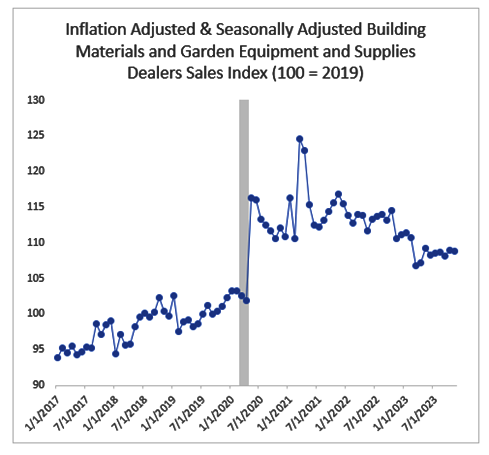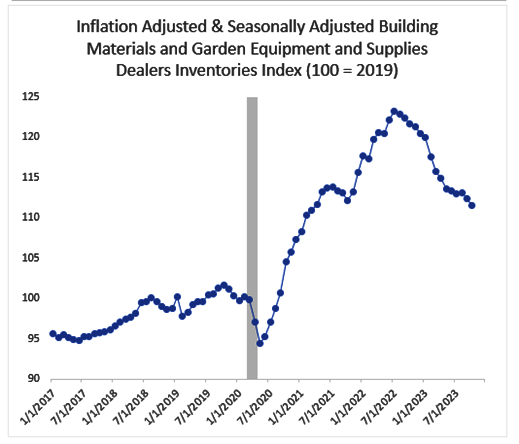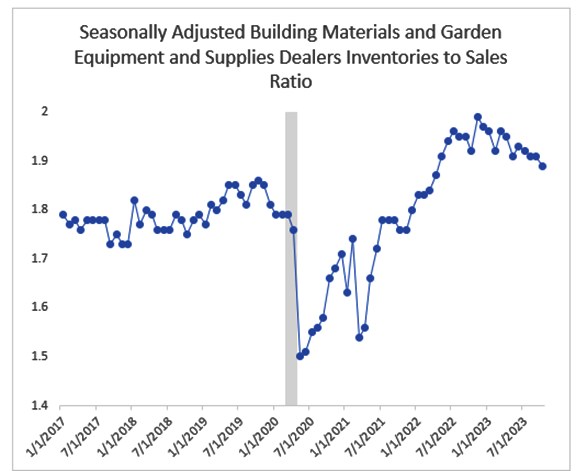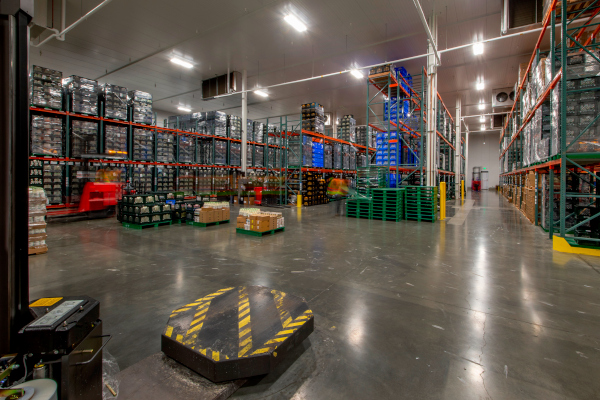Many news articles have attributed the sharp reduction in freight volumes—especially for containerized imports—that were observed in 2023 relative to 2021 and 2022 to the bullwhip effect. However, while this term is very familiar and widely used in supply chain management (SCM), the bullwhip effect is distinct from what companies have been experiencing since the onset of the COVID-19 pandemic.
Our goal in this article is to distinguish the concept that in fact explains these dynamics—termed the inventory accelerator—from the bullwhip effect. We do this by briefly summarizing both concepts, and then illustrating how inventory accelerator dynamics played out in a specific industry sector whose demand was at first supercharged by the COVID-19 pandemic, but then began to fall steeply in 2022 in response to changes in consumer spending patterns, coupled with the sharp rise in interest rates in the Federal Open Market Committee’s (FOMC) attempt to combat a 40-year high inflation.
Defining the concepts
Lee et al. (1997, p. 546) explain that “the bullwhip effect or whiplash effect refers to the phenomenon where orders to the supplier tend to have larger variance than sales to the buyer (i.e., demand distortion), and the distortion propagates upstream in an amplified form (i.e., variance amplification),” [emphasis in original]. In their more business-friendly version of their article in MIT’s Sloan Management Review, Lee and colleagues describe the bullwhip effect as a situation where demand at the retail level has a steady mean but can spike due to temporary factors like sales promotions. When these demand spikes happen, retailers place larger-than-average replenishment orders to upstream vendors (e.g., a wholesaler). The wholesaler—not knowing that the retailer’s demand hasn’t fundamentally increased (since this is a temporary spike)—places an even larger order to its upstream vendor (e.g., a manufacturer). Later, when demand at the retail level does not fundamentally increase, our wholesaler, now left with excess inventory, places an even smaller order with its vendor (the manufacturer). As a result, orders became volatile as we move further upstream in the supply chain.
Unlike this over- and under-ordering scenario with temporary demand spikes that define the bullwhip effect, what firms experienced with the onset of the COVID-19 pandemic was different. Demand for many products like consumer electronics, household appliances, and toys saw sustained increases for most of 2020 and throughout 2021. Demand then fell sharply in 2022 as consumers shifted spending towards services, and the combination of rising interest rates coupled with 40-year high inflation levels resulted in demand destruction. For example, production of major appliances (e.g., ovens, washing machines, dryers, dishwashers, refrigerators, and freezers) fell in late 2022 and throughout 2023 due in part to the decline in new single-family housing starts and existing home sales. This suggests the presence of demand that does not have a constant mean—or in time series statistics nomenclature, demand that is nonstationary. The dynamics of inventories in response to nonstationary demand are better explained by the concept of the inventory accelerator.
The concept of the inventory accelerator is fairly straightforward: it states that a firm’s level of inventory is positively correlated with the firm’s level of demand. What this means is that when demand increases, firms will adjust inventory levels upward and, conversely, when demand decreases, inventory levels will be adjusted downwards. This occurs because firms need to adjust stocks to provide adequate service. As an illustration in the most elementary form, if a firm sets safety stock levels based on the goal of maintaining one week of supply, then an increase in demand levels inherently requires an increase in average inventories because the volume needed to support one week of safety stock supply is higher. Additionally, increases in demand will—on average—cause an increase in average order quantities based on economic order quantity (EOQ) (see footnote 1) principles.
From a freight movement standpoint, the inventory accelerator is an important concept because it predicts that when demand for a firm at a given tier of the supply chain increases in a sustained manner, then that firm’s orders from its upstream vendors are likely to be larger than its unit sales because the firm desires to maintain a higher level of inventory (to support its sustained increased demand). This makes economic (and relatedly demand and inventory) growth even more “accelerated.” However, when demand slows, the same dynamic applies but in reverse. This means that when demand decreases, the decline in orders is larger than the decline in sales as firms attempt to reduce their inventory levels. Just as economic growth is accelerated, firms’ responses to slowing demand magnify the impact of economic downturns, which is why some economists have noted that many recessions during the post-war period were heavily driven by firms either expanding or contracting inventories.
In the next section, we offer a detailed example of how this accelerator effect works by showing how one key industry performed vis-a-vis its inventory levels in response to the cyclical nature of demand that has plagued the US economy since the COVID-19 pandemic.
The inventory accelerator in action: Illustrations from the building material retail sector
The building material and garden equipment and supplies dealers sector (North American Industrial Classification System [NAICS] code 444), which encompasses most operations of firms like The Home Depot and Lowe’s, had annual sales of $326 billion in 2019. As essential retailers, these firms largely remained open during the worst of the COVID-19 lockdowns in March and April 2020. In May 2020, these retailers saw an unprecedented surge in demand as seen in Figure 1, showing seasonally and inflation-adjusted sales (see footnote 2).
From May 2020 through December 2020, inflation-adjusted sales averaged 13% above 2019 levels. Demand was then further supercharged by government stimulus efforts in January and especially March 2021, with inflation and seasonally adjusted sales peaking in March and April 2021 at 23% above 2019 levels. Sales then declined after this peak to levels akin to those observed in the second half of 2020 and remained there until late 2022, when sales fell further. Today, inflation-adjusted sales are still above pre-COVID levels by about 8%, but well below those 2021 highs.

However, focusing only on inflation-adjusted sales does not tell the entire story when it comes to understanding the freight volumes associated with these trends; it is also important to consider how inventory levels evolved over this period. To investigate this, we look at inflation-adjusted inventories (see footnote 3) for this sector (Figure 2). Examining this figure, we can infer the surge of sales in May 2020 clearly caught these retailers off guard, with inflation-adjusted inventories falling sharply. However, we then see a steady rise of these inventories through 2021, with inventories closing out the year at about 15% above 2019 levels. Given that inflation-adjusted sales in 2021 averaged 16% above 2019 levels, we know that these retailers’ orders in 2021 had to be more than 16% above 2019 levels to both fulfill the higher level of demand plus expand inventories. This is the concept of the inventory accelerator making economic boom times even better.

But, alas, those heady boom times for demand couldn’t last. As we moved into 2022, these retailers continued to see a sharp increase in inventory levels, which were excessive given the slowdown of demand. Inflation-adjusted inventories peaked in July 2022 and then began declining. The only explanation for declining inventory levels is if these retailers were not replenishing sales on a 1:1 basis. Consequently, when demand continued to fall in late 2022 and more so through early 2023, upstream vendors were seeing even less demand as retailers started to draw down inventory levels.
The good news for vendors with exposure to this retail sector is that inflation adjusted sales appear to be holding steady, and as shown in Figure 3, the ratio of inventories relative to sales is starting to slowly return to 2019 levels, though it appears there may still be some destocking efforts to complete.
Now imagine these dynamics repeating themselves in sector after sector; this is what we experienced in the U.S. economy through much of 2023. In other words, it wasn’t just slowing demand that caused fewer freight volumes: the need to downsize inventories to bring stocks in line with sales caused orders (and consequently freight movements) to fall even more than sales. Looking ahead with hope that the economy increasingly looking like it has stabilized—the high-frequency Weekly Economic Index supports this claim—and inventories being brought in line with sales, we should see an uptick in freight volumes in 2024, though this may not materialize until the FOMC begins to lower interest rates.

1 Technically with EOQ principles, the days to turn inventories should decrease—interested readers can see this review for full details.
2 We estimate this value by adjusting monthly sales for this sector with an industry-specific sales price deflator from Line 12 of this table produced by the Bureau of Economic Analysis. For simplicity, we report sales as an index where the base (value of 100) is the average for 2019.
3 We calculate these by first deriving an implicit price deflator for inventories based on the BEA’s data for inflation adjusted and not inflation adjusted inventories, and then use this implicit price deflator to incorporate inflation in the Census Bureau’s monthly inventories for this sector. As before, we represent these data as an index where 100 equals the average of 2019.
SC
MR


More Supply Chain Management
- Few executives believe their supply chains can respond quickly to disruptions
- Technology’s role in mending supply chain fragility after recent disruptions
- Survey reveals strategies for addressing supply chain, logistics labor shortages
- How CPG brands can deliver on supplier diversity promises
- How S&OP provides the answer to in-demand products
- AI, virtual reality is bringing experiential learning into the modern age
- More Supply Chain Management
Latest Podcast

 Explore
Explore
Topics
Procurement & Sourcing News
- Israel, Ukraine aid package to increase pressure on aerospace and defense supply chains
- How CPG brands can deliver on supplier diversity promises
- How S&OP provides the answer to in-demand products
- There is still work to do to achieve supply chain stability
- Blooming success: The vital role of S&OE in nurturing global supply chains
- How one small part held up shipments of thousands of autos
- More Procurement & Sourcing
Latest Procurement & Sourcing Resources

Subscribe

Supply Chain Management Review delivers the best industry content.

Editors’ Picks





